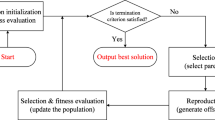Abstract
Many applications in engineering and science rely on the optimization of computationally expensive functions. A successful approach in such scenarios is to couple an evolutionary algorithm with a mathematical model which replaces the expensive function. However, models introduce several difficulties, such as their inherent inaccuracy, and the difficulty of matching a model to a particular problem. To address these issues, this paper proposes a model-based evolutionary algorithm with two main implementations: (a) it combats model inaccuracy with a tailored trust-region approach to manage the model during the search, and to ensure convergence to an optimum of the true expensive function, and (b) during the search it continuously selects an optimal model type out of a set of candidate models, resulting in a model-adaptive optimization search. Extensive performance analysis shows the efficacy of the proposed algorithm.
Similar content being viewed by others
References
Tenne Y, Armfield SW (2009) A framework for memetic optimization using variable global and local surrogate models. J Soft Comput 13(8):781–793
Simpson TW, Poplinski JD, Koch PN, et al (2001) Metamodels for computer-based engineering design: survey and recommendations. Eng Comput 17:129–150
Dennis JE Jr, Torczon V (1997) Managing approximation models in optimization. In: Alexandrov NM, Hussaini MY (eds) Multidisciplinary design optimization: state of the art. SIAM, Philadelphia, pp 330–347
Gorissen D, De Tommasi L, Croon J, et al (2008) Automatic model type selection with heterogeneous evolution: an application to RF circuit block modeling. Proceedings of the IEEE Congress on Evolutionary Computation, CEC 2008, Piscataway, USA, pp 989–996
Zhou Z, Ong Y-S, Nair PB, et al (2007) Combining global and local surrogate models to accelerate evolutionary optimization. IEEE Trans Syst Man Cybern Part C 37(1):66–76
Meckesheimer M, Booker AJ, Barton RR, et al (2002) Computationally inexpensive metamodel assessment strategies. AIAA J 40(10):2053–2060
Burnham KP, Anderson DR (2002) Model selection and inference: a practical information-theoretic approach. Springer, New York
McKay MD, Beckman RJ, Conover WJ (1979) A comparison of three methods for selecting values of input variables in the analysis of output from a computer code. Technometrics 21(2):239–245
Chipperfield A, Fleming P, Pohlheim H, et al (1994) Genetic algorithm toolbox for use with MATLAB, Version 1.2. Department of Automatic Control and Systems Engineering, University of Sheffield, Sheffield
Ratle A (1999) Optimal sampling strategies for learning a fitness model. 1999 IEEE Congress on Evolutionary Computation, CEC 1999, Piscataway, USA, pp 2078–2085
Büche D, Schraudolph NN, Koumoutsakos P (2005) Accelerating evolutionary algorithms with Gaussian process fitness function models. IEEE Trans Syst Man Cybern, Part C 35(2):183–194
Author information
Authors and Affiliations
Corresponding author
About this article
Cite this article
Tenne, Y., Izui, K. & Nishiwaki, S. A model-adaptive evolutionary algorithm for optimization. Artif Life Robotics 16, 546–550 (2012). https://doi.org/10.1007/s10015-011-0987-8
Received:
Accepted:
Published:
Issue Date:
DOI: https://doi.org/10.1007/s10015-011-0987-8




